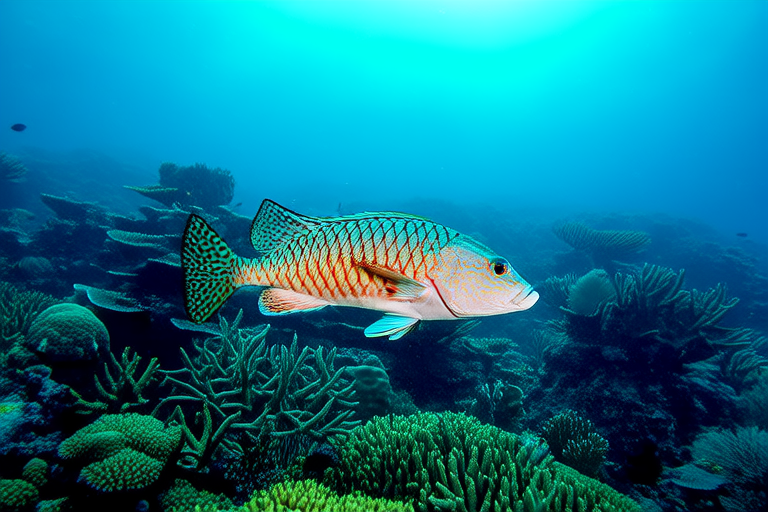How Parrot Fish Are Secretively Shaping Our Oceans: Their Impact Explained
Welcome to an exploration into the hidden world of parrot fish, whose critical role in maintaining the health of our oceans might surprise you. These vibrant, colorful creatures play a pivotal part in keeping coral reefs alive and thriving. In this article, we will delve into the ecological significance of parrot fish, focusing on their grazing behavior, the effects on algae control, support for biodiversity, and the enhancement of reef resilience against climate change.
The Grazing Behavior of Parrot Fish
Parrot fish are known for their unique feeding habits. They possess strong beaks that they use to scrape algae off rocks and coral surfaces. This grazing activity is not just about satisfying their hunger; it’s also crucial for the health of the coral reef ecosystem. By consuming algae, parrot fish prevent overgrowth, which can smother corals and hinder their ability to photosynthesize. Their diet primarily consists of algae and other small organisms, but their impact goes beyond mere consumption.
Scientific studies have shown that parrot fish can remove up to 90% of algae from a reef within a year. This remarkable efficiency ensures that corals receive sufficient sunlight, enabling them to grow and reproduce. The process of grazing also aids in the recycling of nutrients within the reef, contributing to overall reef health.
Algae Control and Coral Health
Algal blooms are a significant threat to coral reefs. When left unchecked, algae can outcompete corals for space and resources, leading to a decline in coral populations. Parrot fish act as natural regulators of algal growth, ensuring that corals have enough room to thrive.
In areas where parrot fish populations are healthy, coral cover tends to be higher, and coral mortality rates lower. Conversely, in regions where parrot fish numbers have dwindled due to overfishing or habitat destruction, algal blooms often dominate, leading to coral degradation. For example, the Caribbean has seen a dramatic increase in macroalgae since the 1980s, coinciding with declines in parrot fish populations. This shift has had severe consequences for coral reefs in the region.
Support for Biodiversity
Coral reefs are among the most biodiverse ecosystems on the planet, hosting thousands of species of fish, invertebrates, and plants. Parrot fish contribute significantly to this biodiversity by creating habitats for other marine life. As they graze, they create pits and depressions in the reef structure, which provide shelter for smaller fish and invertebrates.
Additionally, the waste produced by parrot fish after digestion plays a role in fertilizing the reef. This nutrient-rich excrement promotes the growth of algae and other organisms, further supporting the complex food web within the reef. Without parrot fish, the intricate balance of life in coral reefs could be disrupted, leading to a decline in overall biodiversity.
Enhancing Reef Resilience Against Climate Change
Climate change poses a significant threat to coral reefs worldwide. Rising sea temperatures and ocean acidification are causing widespread coral bleaching events, where corals expel the symbiotic algae living in their tissues, turning white and often dying. In such challenging times, parrot fish can play a crucial role in enhancing reef resilience.
By controlling algal growth, parrot fish help maintain healthy coral communities that are better equipped to withstand environmental stressors. Healthy corals are more likely to recover from bleaching events and continue providing vital habitat for marine life. Moreover, the presence of parrot fish can promote genetic diversity within coral populations, increasing their chances of adapting to changing conditions.
Real-World Examples of Parrot Fish Impact
Several real-world examples highlight the importance of parrot fish in maintaining reef health. One notable case is the recovery of the reefs around the island of Barbuda. After Hurricane Irma devastated the island in 2017, local authorities implemented a ban on fishing, including the protection of parrot fish. Within a few years, the reefs showed signs of recovery, with increased coral cover and improved biodiversity.
Another example comes from the Great Barrier Reef in Australia. Research has shown that areas with higher parrot fish densities tend to have healthier coral populations, even in the face of bleaching events. This underscores the critical role these fish play in sustaining reef ecosystems.
Challenges and Conservation Efforts
Despite their importance, parrot fish populations face numerous threats, including overfishing, habitat destruction, and pollution. Many species are targeted for their meat and bright colors, leading to significant declines in certain areas. To address these challenges, conservation efforts are underway globally.
Marine protected areas (MPAs) are being established to safeguard parrot fish populations and their habitats. These protected zones limit fishing activities, allowing parrot fish to thrive and perform their essential roles in reef ecosystems. Additionally, sustainable fishing practices and public awareness campaigns are helping to reduce pressure on parrot fish populations.
Conclusion
Parrot fish are unsung heroes of the ocean, quietly shaping the future of our coral reefs. Their grazing behavior, while seemingly simple, has profound implications for algae control, biodiversity support, and reef resilience. As we face the challenges of climate change and human-induced impacts on marine ecosystems, understanding and protecting parrot fish becomes increasingly important.
By recognizing the vital role these fish play, we can take steps to ensure their survival and, in turn, the health of our oceans. Let us strive to preserve these vibrant creatures and the incredible ecosystems they maintain, for the benefit of all marine life and future generations.
